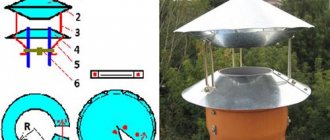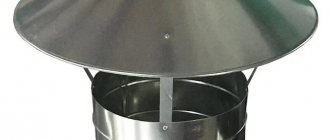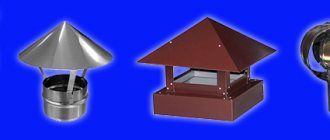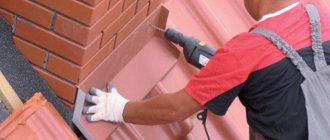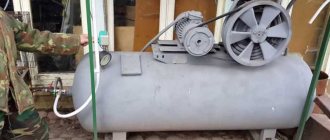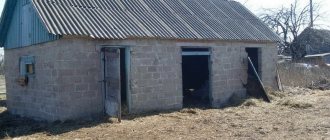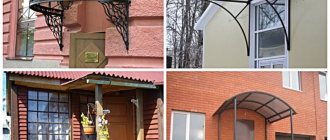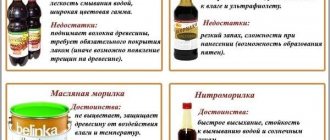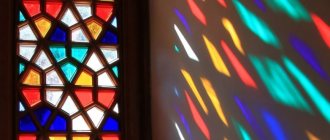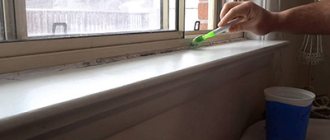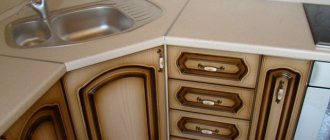A reliable, stylish and durable chimney cap can be purchased or made independently. Moreover, many are attracted by the second option, because this is another opportunity to craft, show ingenuity and give the exterior of their home another original touch. Even if such a chimney does not have perfect seams and every millimeter has been brought to perfect geometry, it will still look good, “like home,” and from a distance small errors will not be noticeable.
Just first, decide what exactly you want to get as a result: a simple but nice classic chimney cap or a more complex design with additional functions and creative design. Both of these can be brought to life! And we will tell you in detail how to make each of these options and what you will need for this.
Choice of shape and material
The chimney cap was invented quite a long time ago . It solves several practical problems:
- protects the chimney from external factors: rain, snow and wind;
- acts as an additional roof decoration.
It is important to provide, first of all, protection from wind and precipitation, otherwise the walls of the chimney will be destroyed under the influence of weather conditions.
The cover should be selected in accordance with:
- channel type;
- hole diameter.
Based on these indicators, select:
- a cap made of chrome and nickel if the house is heated with gas;
- a removable product if the apartment is heated by a fireplace, solid fuel boiler or wood stove.
The main types are models with a round and square base, stationary or folding, made of tin - chromium-nickel or black. Many modifications are unfounded. They are fixed directly to the chimney duct.
Today, chimneys made of galvanized or stainless steel and copper have appeared. It is also possible to select modifications so that the shade of the cap matches the color of the roof. The selected option must correspond in functionality to the specific type of pipe. It should also match the style of the building.
Spot lighting
When choosing what kind of lighting is needed for the bathroom, it is necessary to proceed from the practical characteristics of the room itself and the finishing materials used.
For panel and stretch coverings, the ideal solution is the use of spotlights that are installed on different surfaces and provide the necessary lighting intensity.
A lot of small and bright lights are easy to use in creating a design composition, for light zoning of a room and to complement the interior concept.
Architectural form
As for the architectural shape of the cap, a multi-slope weather vane can perfectly protect against precipitation and snow. This chimney looks very impressive, especially if you place figures of any animals made of metal on top.
Models with a flat surface are more often used. There are caps with an opening lid, which are also popular. They are convenient for preventive maintenance and unhindered maintenance of the chimney. The deflector, which has a ventilation hole in its body, significantly improves traction.
But the smoker is not always used. There is virtually no need for it in areas where there is rarely precipitation and virtually no wind. But for Russian latitudes it is a necessity.
The principle of operation of weather vanes
The operation of the deflector is based on the following actions:
- Air flows, bending around the walls of the upper cylinder, hit it. Sliding along its surface, they turn upward and suck in the gases coming out of the pipe.
- After installing the chimney, the air inside the pipe moves more intensely and thus increases draft.
- With a vertical or oblique wind direction, the visor provokes a further increase in thrust. Air flows penetrate through the gap of the device into the upper cylinder and suck in the smoke coming out of the pipe.
- If the wind blows downward, vortices appear under the top of the visor, which slow down the exit of smoke.
Chimney umbrella
A chimney hood can be installed for several reasons:
- it is capable of partially closing the mouths from blowing wind, due to which the draft is prevented from overturning;
- the chimney prevents small debris from getting inside;
- mesh design provides protection from nesting birds;
- such a product extends the service life of the head of a brick pipe, which can be destroyed under the influence of precipitation;
- A weather vane of this type has good decorative qualities, and therefore is able to complement the architectural appearance of the building.
What is the difference between an umbrella and a weather vane, cap, head and chimney?
The chimney, weather vane, cap, umbrella and cap are quite simple and time-tested protective structures for air outlets on the roof . Steel, copper, aluminum, plastic and titanium-zinc additional elements, when properly installed, can be used for ten and sometimes more years, providing comfortable and safe living:
- caps - the general name of elements that prevent precipitation and foreign objects from entering the chimney, as well as carrying a decorative load;
- chimneys - rectangular or square decorative caps designed for arranging chimney and ventilation pipes;
- umbrellas - are represented by caps that are simple in design and designed for round or square pipes;
- deflectors - caps on round pipes, characterized by a rather complex internal design to increase traction.
The category of complex structures also includes weather vanes - rotating caps that direct the escaping smoke exclusively in one direction, depending on the direction of the wind.
Installing the hood
Here you should focus on safety and practicality. The last thing you need to think about is the external attractiveness of the structure. It is important to consider the following recommendations:
- Round steel pipes cannot be covered with traditional shaped structures. They remove smoke from highly efficient boilers whose efficiency exceeds 85%. It is better to use conical nozzles made in the form of an open nozzle. They will not become covered with a crust of ice in freezing temperatures.
- A brick chimney, devoid of inserts, connected to a high-efficiency heat generator, can be equipped with a cap-shaped nozzle. A pipe passes through it.
- It is advisable to install an umbrella on stoves with vertical channels. This shape performs a protective function on the chimney. But to make this possible, it is advisable to place a stainless steel plate inside.
It is recommended to install hip or gable hoods on smoke exhaust blocks made of brick and equipped with side vents. Due to this, the upper part of the masonry will be protected from precipitation and wind. In this case, contact with the gas duct openings on the sides will be excluded.
To protect a brick block, where chimney and exhaust pipes are open at the top, you can make a box with several through pipes. They, in turn, are inserted into the specified channels. Conventional mushroom-shaped caps are installed on top of the ventilation terminals, while conical nozzles must be installed on gas terminals.
Information on the purpose of the calculator
The online brick calculator is designed to calculate the amount of building and facing bricks for a house and basement, as well as related parameters and materials, such as the amount of masonry mortar, masonry mesh and flexible connections. Also, the calculations can take into account the dimensions of gables, window and door openings of the required number and size.
When filling out the data, pay attention to the additional information with the Additional information sign
Since ancient times, brick has been the most popular, widespread and familiar building material for the construction of long-term and reliable structures. This situation persists for a number of reasons, despite the emergence of new, modern and cheaper building materials. There are several most common types of bricks for any construction needs:
- Adobe - made of clay and various fillers
- Ceramic - (most common) made from baked clay
- Silicate - made of sand and lime
- Hyper-pressed - from lime and cement
- Clinker - made from special baked clay
- Fireproof - (fireclay) made from fireclay
Ceramic brick
(clay) are divided according to purpose into façade, ordinary and clinker. Ordinary brick (backfill) may not have an ideal geometry and in most cases is used for laying rough walls of houses, plinths, garages, which are subsequently plastered, painted and protected with facing materials and coatings. Its color has various shades of red.
About facing
(facade) are used for the construction of walls without any additional finishing in the future. There are also various special types of facade bricks that can withstand high mechanical loads and adverse atmospheric influences, and are usually used for paving paths, building all kinds of retaining fences, stairs, and walls.
K linker
It has an ideal smooth surface, various shades of red and black colors and is highly dense.
With silicate
is a light-colored lime-silicon artificial stone. Sand-lime brick differs from ceramic brick in that it is not fired during the manufacturing process. It is quite hygroscopic, and accordingly is not used for the construction of objects that will be operated in humid environments, such as the basement and basements.
Also, sand-lime brick is not used in the construction of furnaces, pipes, chimneys and foundations, since it withstands external destructive loads quite poorly.
Oh fireproof
is divided into several types and is used for the construction of structures exposed to high temperatures, such as stoves, fireplaces, chimneys and smelters. The most common is fireclay brick, it has a yellowish tint, made from special fireclay (chamotte) and, unlike ordinary clay brick, can easily withstand high temperatures (up to 1400 degrees), as well as numerous heating and cooling cycles without loss of strength.
Irpichy can be solid (volume of voids no more than 25%), hollow and porous-hollow. It is believed that depressions and voids in the material not only reduce weight, but also significantly increase the overall strength of the masonry by increasing the contact area between the brick and the mortar.
The most common standard brick size: 250 - 120 - 65 mm (length - width - height), the so-called first “normal form” (1NF).
When calculating the amount of brick required for work, they usually use a rule called “format”, in which the dimensions of the brick itself are increased by 10 mm (this is the standard joint thickness), that is, it turns out: 260x130x75 mm.
Below is a complete list of calculations performed with a brief description of each item. If you haven't found the answer to your question, you can contact us via feedback.
Making a visor
You can make a cap for the chimney pipe with your own hands. The drawings will help you navigate this, but it is important to follow all the parameters specified in it. First of all, you need to determine the external dimensions of the head. The umbrella will be attached here. Following this, you need to sketch a sketch depicting the future structure. To do this correctly, you need to consider the following points:
- the diameter of the product must be 10 cm larger than the dimensions of the pipe so that the edges protrude on all sides up to 50 mm;
- slope angles should vary from 30 to 45 degrees;
- from the chimney cut to the fungus, the minimum height should be 100 mm.
An umbrella is a traditional solution . There are other design options:
- rotating weather vane;
- deflector.
The latter makes it possible to increase traction through wind pressure. Thanks to it, a vacuum is created in the cylindrical body, into which the smoke channel passes. In calm weather, this device retains all its positive qualities. At the same time, it reduces the traction force in the pipe, which results in increased resistance at the exit of combustion products.
A semi-cylindrical weather vane is often popularly called a “sycophant” because it turns with the wind. It is mounted on a special bearing and consists of several components. This is one of the best options, but there are doubts about the reliability of the bearing, and the price of this design is high. It is especially good to install such a model on a round chimney, as it protects the mouth of this device from precipitation and blowing out.
To make a chimney for a canopy with your own hands, it is better to use painted or galvanized metal, the thickness of which is at least 0.5 mm.
What are fungi for ventilation pipes made from?
Before making a canopy for the pipe, you need to decide on the material. Most often, non-ferrous and ferrous metal is used to make fungi; the thickness does not matter. The most widely used products are products made from galvanized sheet metal.
The most common material is galvanized sheet Source by.prom.st
The finished product is painted in color to improve its appearance, since black steel has an unattractive appearance. To improve the appearance, the product can be additionally decorated with forged elements. But caps made of black steel will have a significant disadvantage - weight, which is why the design is not suitable for all roofs.
If weight is an important parameter, then copper and alloy steel mushrooms should be considered. The disadvantage of structures made from these materials is their high cost. Therefore, the second criterion when choosing material for a canopy is the financial capabilities of the building owner. To save money, canopies are often built with their own hands, using high-quality materials.
Making a Simple Round Umbrella
To perform such work, you need to prepare tools: a drill, metal shears, a hammer and equipment for installing rivets. Once the size of the fungus is determined , work is performed in the following order:
- Screw two self-tapping screws into a wooden plank, maintaining a distance between them equal to the radius of the product + 15 mm. It turns out to be a homemade compass, with which you can make a mark on the metal, marking the central part of the circle. Its outline is also drawn.
- The workpiece is cut with scissors, after which a sector is drawn, the arc length of which is 120 mm. The resulting figure is somewhat reminiscent of a piece of cake.
- The indicated wedge is cut out, and then the outer edges of the figure are aligned with force. Fix them with a vice.
- Drill three holes along the resulting line and connect the ends of the part with screws or rivets. The upper part of the weather vane can be considered ready.
Using steel strips, legs for the fungus and a clamp encircling the pipe are created. They take thin sheets that are bent several times. These parts are similarly secured to the umbrella with rivets.
Attaching a wind board for metal tiles - step-by-step diagram
Step 1: Attaching the Bar
Since there is also sheathing underneath the shingles, it is important to trim it as in the previous method. Then it’s time to attach the strip, one side of which is thrown over the last row of tiles, and the second hangs parallel to the gable, tightly pressed against the ends of the battens
Fastening is carried out with roofing screws the color of tiles, the distance between them is maintained up to 60 cm, it is important to ensure that they are located exactly at the level of the ends of the sheathing, because fastening to the air is stupid. The maximum length of such wind boards is 2 m, therefore, several will have to be laid along the length of the roof, making an overlap of 5 cm.
Step 2: Hiding Defects
You should avoid over-tightening the screws so that unsightly waves of metal do not form; it will be difficult to fix this if you do not notice it in time. But it is also better to eliminate scratches that will inevitably accompany the entire installation process immediately after work, otherwise corrosion will not keep you waiting. The easiest way is to paint them over. Use spray paint for this, just choose the color carefully.
Gable model
To make a gable weather vane, you need to use a machine called a sheet bender.
Just as in the previous case, first measure the outer surface of the brick chimney. Calculate the pattern and make the corresponding diagram. Next, the cap is assembled using a simple algorithm.
You need to cut the metal and bend it following the dashed lines. The resulting parts must be connected with rivets. The function of rigid racks is performed by ready-made corners made of painted metal , the thickness of which varies from 0.5 to 0.7 mm.
How to choose
When choosing a hood, you need to base it on the functions for which it will be intended.
When choosing a ventilation hood, you should pay attention to the following characteristics:
- Dimensions. To select the size, assume that the width is 10 centimeters larger than the surface for which it will be installed.
- Room temperature. When choosing, you should take into account the temperature of the vapors and gases entering the chimney. On this point, it is better to consult a specialist.
- Air flow. This indicator is calculated from the volume of the room, power and number of installed plates. Prepare this information before purchasing and present it to a specialist.
- Air speed and resistance. The air exchange of the umbrella should be from 0.8 to 1.5 meters per second. If the speed indicator is lower, this will significantly reduce the quality of work.
When choosing, pay attention first of all to the type of umbrella you need (see above), and when purchasing and manufacturing, proceed from this parameter
European cap
This model is more designed to prevent the formation of condensation and has a rounded appearance. A chimney of this type can be made independently using a steel sheet and hand-made holders.
How to make a European cap:
- Take a standard metal sheet and carefully bend it around the pipe, or directly along the contour of the chimney.
- They remake the spoons that will hold the cap directly on the pipe. It is best to do this with a special machine or ask a welder you know. You can also make transverse cuts that do not go all the way and carefully bend the strips using pliers.
- These cuts do not have to be transverse. It is permissible to use longitudinal strips if the piece of metal is quite long. A rectangle is cut out along the edges and the tails are left in the center. After this, roll the sheet in the shape of a semicircle and press the tails with a clamp.
- Gently bend the legs.
It is permissible to use a regular chimney pipe clamp to mount such a cap on the pipe.
To make a European cap, all you need is a piece of sheet metal and a grinder disc.
Basic installation rules
The installation of a smoke hood directly depends on the design features of the additional element and chimney pipe, as well as the material used in manufacturing. Based on standard rectangular sheet steel, the easiest way to create a tetrahedral pyramidal umbrella is by bending the sheet of material a couple of times in a diagonal direction.
This option is traditional for arranging chimney pipes on hipped roofs, but to attach racks and further installation it is necessary to use additional elements in the form of corners, as well as drill holes.
Simple vaulted umbrellas with a minimum number of folds and cuts have a less complex design. Fixing such a smoke umbrella on an oval chimney pipe is carried out due to the presence of racks bent from sheet steel of sufficient thickness or made using standard metal corners.
Classification
When choosing a visor, consider several characteristics.
By material
The durability of the visor depends on the quality and type of materials
When choosing options, pay attention to copper fixtures. Such material, as it ages, becomes more attractive and will reliably serve for 50 years.
The main part is the umbrella, which is best made of stainless steel or galvanized. Or you will have to remove the cap every year and re-paint it.
Inferior to a copper visor in terms of service life by 15-20 years, stainless steel parts are much cheaper.
Titanium is attractive for its durability and good metal properties, but is more expensive than stainless steel.
Therefore, in this question (which cap is better?) there is no clear advice.
Someone buys a copper cap with an architectural composition, or a simple galvanized umbrella - any design must reliably protect the chimney. And appearance is a secondary concept.
By shape
Here the choice is so individual that it is impossible to give advice. We’ll just list the shapes of the caps, and the choice depends on the preferences of buyers or home craftsmen:
- semi-cylindrical or vaulted;
- hipped, the simplest and most popular design;
- hipped - closer to the European style of buildings and roofs;
- with two slopes, found on half the roofs in the country;
- made in the form of a tower spire, reminiscent of caps in Gothic castles;
- flat with a slight bevel - this design is usually installed on the modern style of building architecture.
You can often find hoods with built-in weather vanes, with a special damper designed to provide sufficient draft and exhaust gases to escape even in strong gusts of wind.
The air flow entering the chimney creates an air lock and reduces the amount of oxygen in the combustion chamber to a minimum.
By purpose
According to their purpose, protective devices are divided into:
- a cap installed on the chimney of a stove operating on solid fuel;
- for servicing heating boilers and pyrolysis furnaces, install canopies with open nozzles;
- Boilers operating on gas or diesel fuel are equipped with deflectors with an open nozzle. Such devices create additional draft and can serve to ventilate the entire room and create favorable conditions for fuel combustion.
Types of deflectors
Simple heads work worst when air flows from bottom to top. Hitting the hood, they are repelled and move towards the streams of smoke rising from the chimney. The pressure at the top of the chimney increases and the draft overturns. Deflectors are more effective in this case.
These are structures with a diffuser designed to capture the wind, disperse its currents and remove it. This creates a vacuum inside the deflector, which causes streams of hot air from the chimney to rush upward. Conventional caps provide some stabilization of the pressure at the top of the chimney. But if they increase draft by 15 - 20% compared to an open pipe, then diffusers increase this percentage to 30 - 40%.
There are several types of deflectors:
- TsAGI.
- Volpert - Grigorovich.
- H-shaped deflector.
- Rotary: spherical, weather vane.
The Central Aerohydrodynamic Institute has developed a universal deflector model. It consists of a ring fixed to the chimney and an umbrella with a cylindrical screen connected to it. Wind flows entering the structure from below are dissipated, hitting the umbrella cover and the walls of the cylinder, then exit through the gaps between them. The chimney is protected from precipitation and strong directional wind.
Has disadvantages:
- In calm weather, traction worsens.
- In severe frosts, the small distance between the umbrella and the cylindrical screen may become covered with ice, preventing the passage of smoke.
The Volpert-Grigorovich deflector looks like a two-tier “skirt”. Its lower part is a truncated cone or cylinder, the upper part is 2 cones, direct and reverse. The curved surface of the diffuser is effective in low winds.
The H-shaped deflector is similar in outline to the letter N. The smoke channel is connected to a transverse pipe of the same diameter, at both ends of which there are two pipes parallel to the chimney. Wind flows can only enter the side channels. Most of them immediately go up, without interfering with the waste combustion products. The remaining part, entering the transverse channel, is not capable of creating serious pressure and is discharged along with the smoke. No smoke. A canopy is not required in this design, since the mouth is protected by a transverse pipe.
The round turbine stands still in calm weather, without preventing smoke from escaping from its openings. Under the influence of the wind, it rotates, creating a reduced pressure inside and increasing traction. Deflectors, which have aerodynamic properties, rotate around their axis under the influence of air flows. A weather vane or weather vane protects the mouth of the smoke channel from wind flows, which are forced to bypass it, creating a vacuum.
Rotary deflectors are usually installed where gas heating equipment is used. For TT boilers with high flue waste temperatures, it is not recommended to install them.
From all that has been said, we can draw conclusions:
- If the head is mounted on the chimney of a TT boiler, then a simple cap made of copper, zinc-titanium or stainless steel will be sufficient. It is better not to install nets in areas with very frosty winters to avoid icing.
- For gas heating boilers, deflectors that improve draft are acceptable. In areas with frequent winds at higher elevations, their susceptibility to air currents will come in handy.
- It is advisable to make the caps for brick chimney pipes with side air ducts, especially from equipment with high efficiency, gable or hip, which do not block the passage of exhaust gases.
Lamp placement levels
The photo of the light in the bathrooms shows three levels of placement of appliances. Lighting is installed in this room:
- top,
- average,
- lower.
Ceiling lights are necessary for the convenience of using the room. They create the main light and illuminate all areas. In the range of lighting products you can find options for a room of any size, taking into account the style and design features. Chandeliers and lampshades can be located on the upper level; spotlights can be used in the bathroom.
Ceiling lights create the main light
Mid-level lighting is called task lighting. This area contains light sources that provide comfort during procedures. For the most part, wall-mounted models are chosen for these purposes.
Mid-level lamps provide comfort during procedures
Lower light is not a necessary element to create proper comfort. This lighting is decorative, used to give the interior originality and create a special atmosphere. In addition, installing lamps in the lower zone allows you to perform visual correction, expand the room, and make it more spacious.
Bottom light creates a special atmosphere
